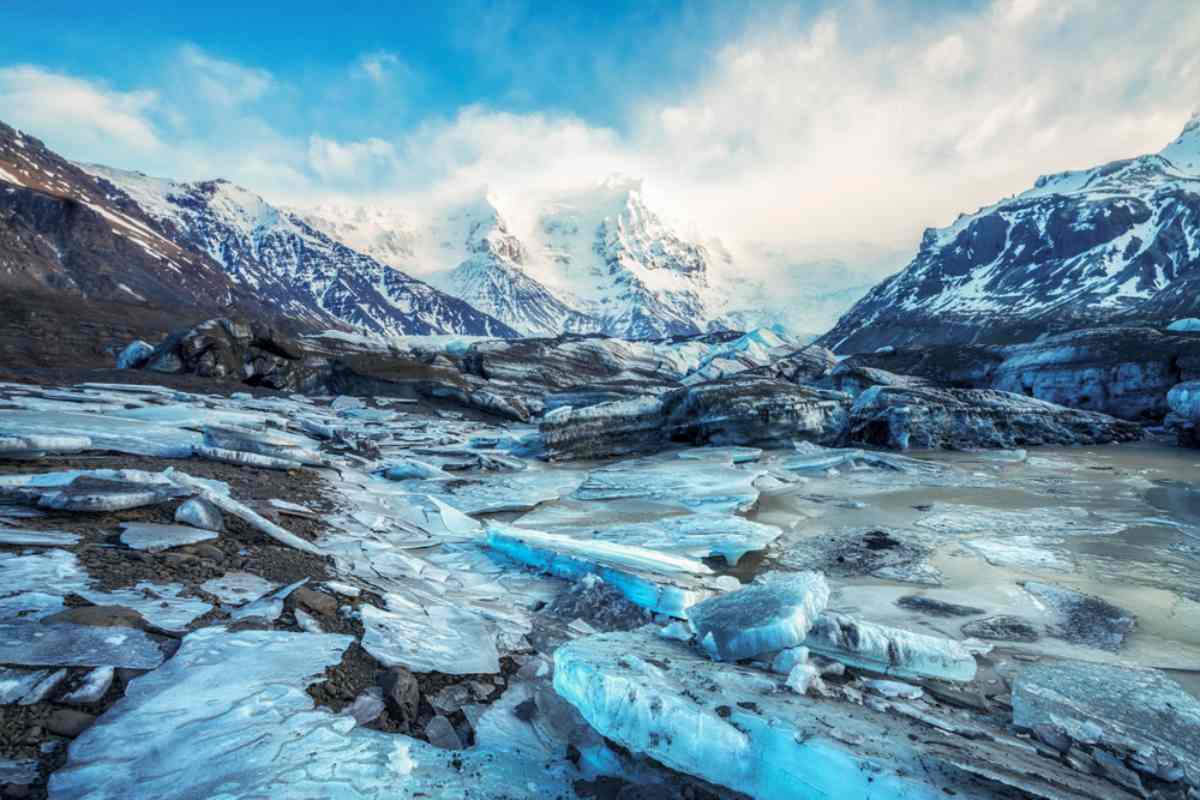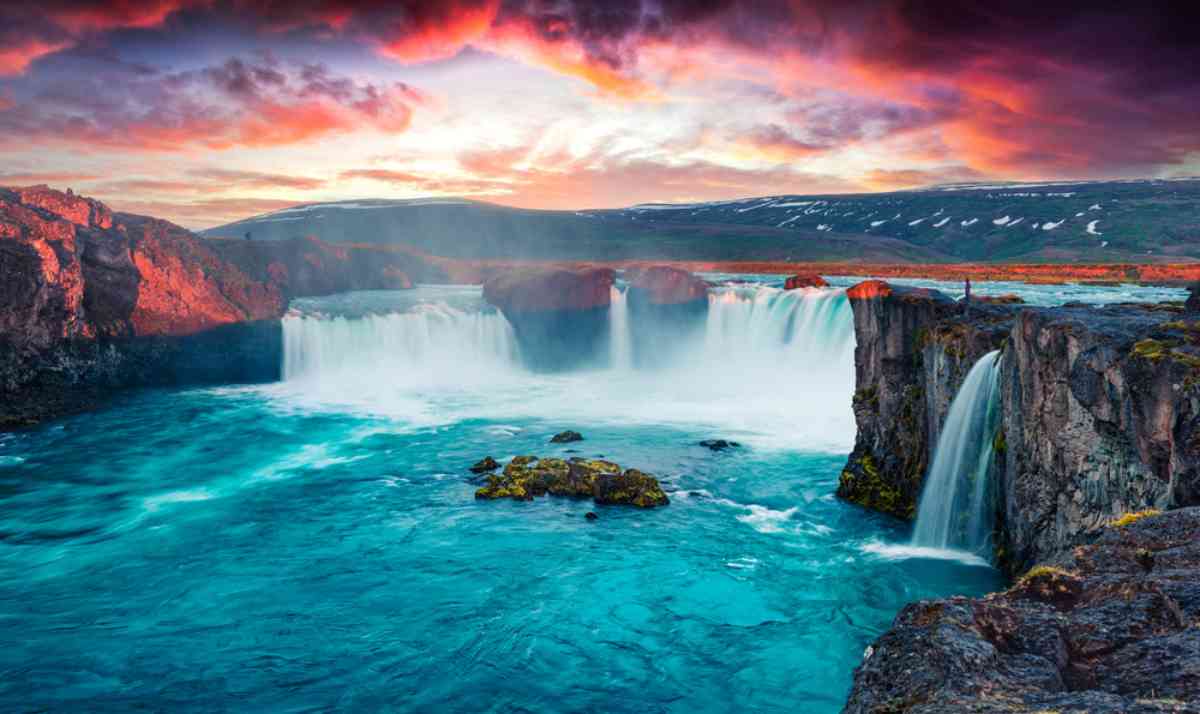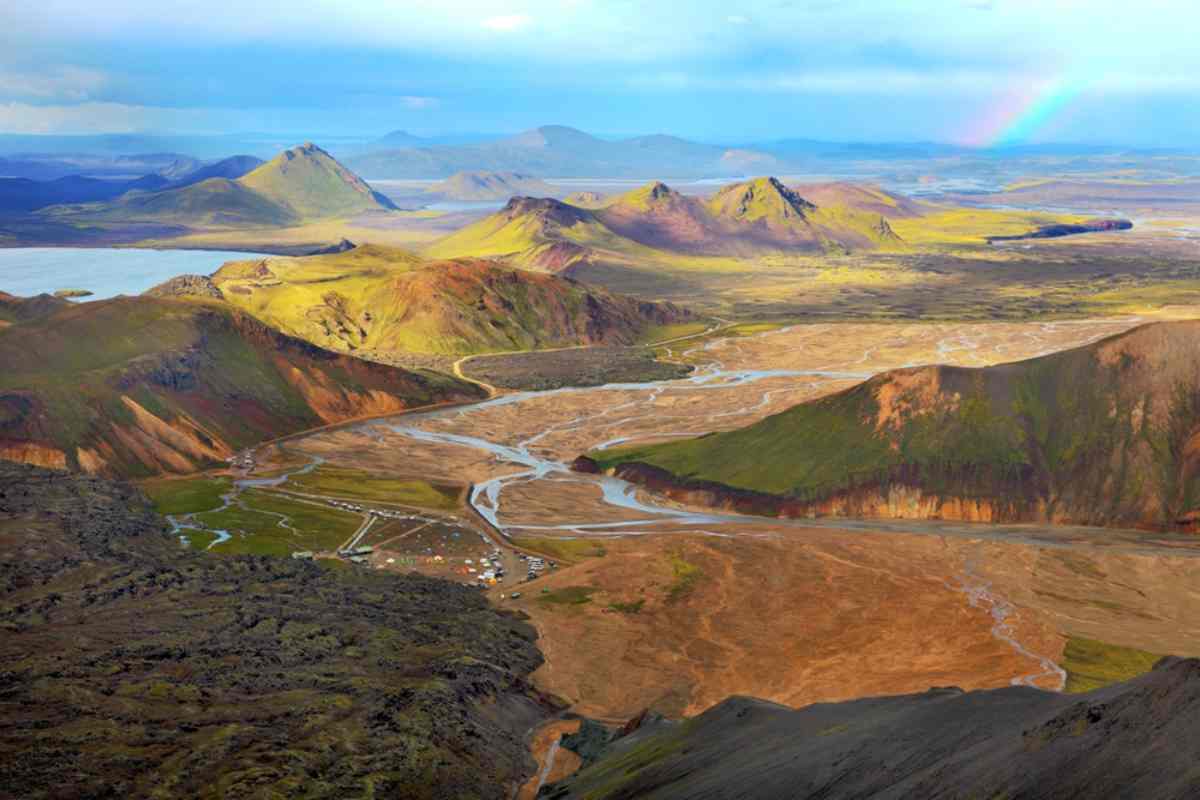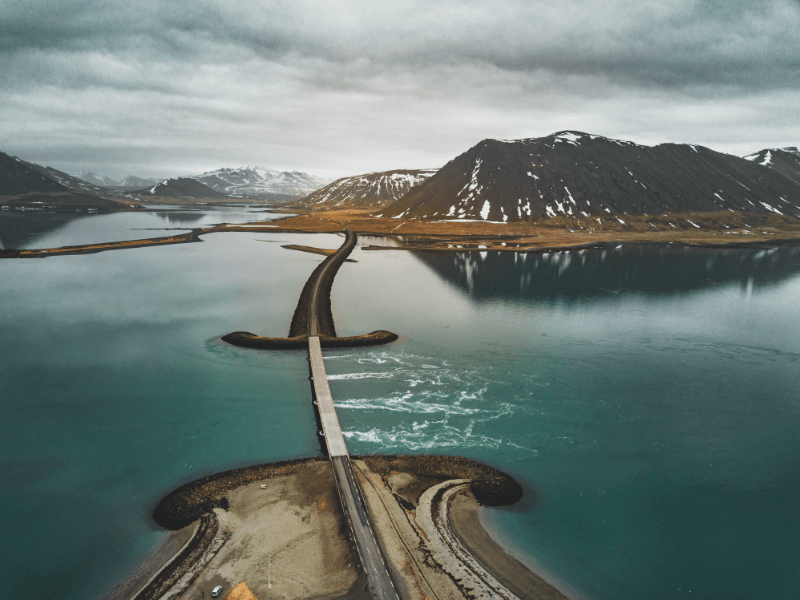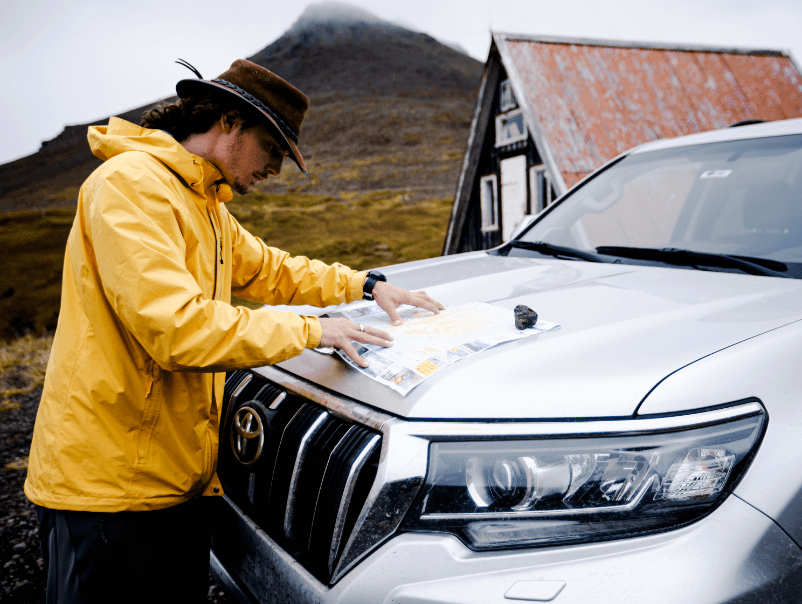Námaskarð (or Námaskarð Pass as it’s also known) is the perfect example of the effects being the Land of Fire and Ice can have on the landscape. This strange-looking place, with its steamy hot spots (literally) and vibrant colors, makes it feel like you’re walking around an alien planet.
But whenever you head out north here on the island, Námaskarð is a must-visit and an essential item on any Iceland trip itinerary. In this article, we give you the lowdown on this interesting place with all its unique geothermal features and tell you all you need to know to plan a visit.
Námaskarð Geothermal Area: An Introduction
Námaskarð Geothermal Area is located in Northern Iceland, between the Namafjall and Dalfjall Mountains, near the famous Lake Myvatn, and just 5 kilometers east of Reykjahlid. Its name is derived from the Old Norse word “nam,” roughly translating to “mining” and “skor,” roughly translating to “mountain pass.” which indicates Námaskarð may refer to a mining pass.
These already serve as excellent clues as to the scenes awaiting visitors here. This area has completely otherwordly characteristics. It looks like a colorful desert filled with fumaroles, bubbling mud pools, and hot springs (NOT the kind you can take a dip in!) with steam continuously rising from the landscape.
The heat from the underground Krafla volcanic system created this impressive, what can only be described as a volcanic piece of art on the earth’s surface. The ground is completely sterile, so you won’t find any vegetation here. This is because of the geological makeup and emissions found here in Námaskarð:

- As the boiling mud and water have made clear, the ground here is extremely hot, and it will take a pretty resilient little seed to stick it out and survive here.
- The various colors are caused by the Rhyolite and all sorts of minerals such as iron, silica, and sulfur found here. In fact, you will immediately become aware of a strong rotten egg smell. Don’t suspiciously look your companion’s way. It’s merely the distinct smell of the sulfur.
- The area is extremely acidic due to the large and continuous emissions of acids, further making it impossible for anything to survive and grow here.
- On top of all this, poisonous fumes are also constantly being expelled, gassing anything with a will to live. Visitors can have the peace of mind, though, that a couple of hours at the site won’t cause any harm (so you can let those post-apocalyptic horror-movie images go), but if you were to live here and breathe in the air long-term, your health would also definitely be impacted. However, it can cause respiratory discomfort for sensitive visitors, such as those with asthma or respiratory issues. In such cases, bringing a mask or scarf to help with the strong smell and limiting exposure time is recommended.
If you ever hear anyone call the area Hverir or Hverarönd, none of you are wrong. The three names are used interchangeably for the geothermal area, although, technically, the names Hverir or Hverarönd actually refer more to the area, while Námaskarð refers specifically to the pass across the mountain ridge.
How Námaskarð was Formed
Námaskarð wasn’t created by one geological event like many of our natural wonders here on the island. As we already touched on, the geothermal area is caused by the extreme heat emanating from the Krafla volcanic system underground.
Although the Krafla volcanic system is quite extensive, with multiple volcanoes (literally) linked to it and causing many of Iceland’s famous “hot spots” and affecting nearby sites such as Viti crater or Grjótagjá Cave.
Námaskarð is located pretty close to the head honcho, and very active, Krafla volcano itself. Krafla has had numerous eruptions, some of the latest being in 1975 and 1984, and many believe that we’re overdue for another one.
But don’t worry, visiting Námaskarð is perfectly safe, and you can rest assured that the Land of Fire and Ice is well-equipped to read the warning signs and handle any possible eruption safely and quickly. Essentially, what happens at Námaskarð is that the volcanic system heats up the underground water supply (and note that there have been parts of the Krafla volcanic system found to be 900 degrees Celsius, about 1650 degrees Fahrenheit!

The hot water and subsequent steam then rise through the cracks and fissures in the ground, creating all the interesting geological and geothermal “symptoms” of the volcanic activity found on the surface.
Geothermal Power: The Bigger Picture of the Krafla Volcanic System
You might’ve already heard of the geothermal power of Iceland. This is when heat from the underground volcanic systems is used to power the turbines to create electricity. While Iceland runs on 100% renewable energy, roughly 73% is generated via hydropower (using water), and about 27% is generated via geothermal power. With that being said, the Krafla Geothermal Power Plant, using the Krafla volcanic system, is responsible for a large portion of that percentage.
A Breakdown of Námaskarð’s Colorful Landscape
Learn how to identify the specific mineral deposits by using the cheat sheet below:
- Yellow – Sulfur
- Red and Brown – Oxygenated Iron
- Light Colours – Silica and Calcium
- Pink, Bluish-Grey, or Reddish-Purple – Oxygenated Rhyolite
Getting to Námaskarð in Iceland
If Námaskarð doesn’t give you enough reason to road trip around the island via the Ring Road, we don’t know what will. The Ring Road cuts straight through the geothermal area, so you literally can’t miss it. You will have two options when it comes to driving the Ring Road from the capital city of Reykjavik (from where most visitors start their Iceland adventure):
Via the Ring Road (Clockwise)
This is roughly a 6-hour long journey without any stops, so you can use that little detail when creating your trip itinerary. On this route, you will travel:
- From Reykjavik.
- Through Borgarfjördur.
- Over Holtavörduheidi Heath.
- Through Borgarnes and Skagafjördur.
- Past Akureyri (the so-called capital of the north).
- Past Lake Myvatn.
- Arrive at Námaskarð.
Via the Ring Road (Counter-clockwise)
This is roughly a 10.5-hour long journey without any stops, so you can use that little detail when creating your trip itinerary. On this route, you will travel:
- From Reykjavik.
- Along the South Coast.
- Past Seljalandsfoss, Skogafoss, and the glaciers of the Southeast.
- Through the towns of the Eastfjords and Egilsstadir (the so-called capital of the East).
- Arrive at Námaskarð.

The Best Time to Visit Námaskarð
Since Námaskarð is an outdoor attraction, your visit will undoubtedly be impacted by the weather. And then there are also some personal preferences to take into account. So, in order for you to decide when you would like to visit the geothermal area, we suggest you take the following into consideration:
- Námaskarð is in the north of Iceland. The north is renowned for having much colder and harsher weather than the rest of the country. That’s also why the region is plagued by sudden closures of roads and attractions during the winter, and certain roads, such as the F-roads, are closed annually. So, if you’re someone who prefers the summer heat, and you’re a bit of a nervous driver, or just want to explore the region properly, we’d recommend you give the colder months a skip.
- The best time to visit Námaskarð if you want to have plenty of daylight hours and the best weather will be summertime. Temperatures are at an all-time high, you don’t need to combat extreme weather elements such as blizzards or 35+ kilometer-an-hour winds, and you’ll be treated to 20+ daylight hours each day.
- The abovementioned is also why most visitors choose to visit the island during the summertime, hence why it’s considered our peak season. Peak seasons inevitably mean peak season crowds and peak season prices (the latter might not necessarily affect your visit to Námaskarð but will impact everything else around your trip, such as accommodation, food, etc.
- Those who wish to avoid these peak season crowds and prices should rather visit during one of the summer shoulder months (April, May, September, or October). You’ll still have decent weather and plenty of daylight hours, but you won’t have to worry about those pesky peak season drawbacks.

A Few Helpful Tips for Visiting Námaskarð
If this will be your first time visiting Námaskarð or a geothermal area here in Iceland, the following tips and advice will be very helpful:
- Always stay on the clearly marked and outlined paths and walkways at Námaskarð. This is for your own safety. These geothermal areas with bubbling and boiling pools of water and mud and steam vents are not to be trifled with. Just ask Ed Sheeran what can happen if you’re not careful.
- Ensure that you’re wearing layers before heading out to Námaskarð. That’s because, irrespective of the season, you will inevitably get hot at the geothermal area. By wearing layers, you’ll be able to take things off at Námaskarð but then put things back on again once you’re off to colder pastures.
- To always be on the safe side, you need to keep an eye on the Icelandic Weather Forecast and the Icelandic Road Conditions to ensure you don’t get caught by surprise.
- Remember that we Icelanders take great pride in and care of our environment. So, be sure to only leave your footprints behind when visiting Námaskarð. Take any rubbish and litter with you till it can be discarded in a bin.
Other Things to See and Do Near Námaskarð
If you would like to explore Námaskarð’s surrounding area a bit more, the following are considered must-visits:
- Myvatn Nature Baths
- Krafla Volcano
- Viti Crater
- Dettifoss Waterfall
- Hverfjall Crater
- Grjotagja Cave
- Námafjall Mountain (famous for going hiking)

Ring Road Your Way to Námaskarð in a Camper
Námaskarð is the ideal stop along a Ring Road road trip, and the most convenient and comfortable way to cruise around the country is definitely in a campervan. This doesn’t just mean you’ve ticked both transport and accommodation off your to-do list in one fell swoop.
But it also means that you can take advantage of our affordable (and breathtaking!) campsites. For example, if you would like to thoroughly explore Námaskarð and its surrounds, we recommend that you book a spot at the Myvatn Campground. So, use this article as a guide to plan and prepare your trip, then rent a campervan in Iceland and come Ring Road your way to Námaskarð in a camper!



 By
By 
